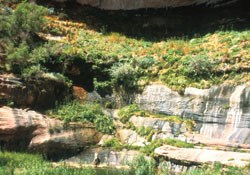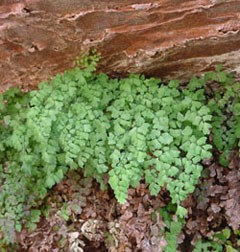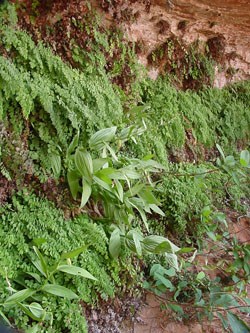
NPS/Stephanie Metzler Water sources in the desert are rare and often critically important for wildlife. Streams and springs support lush, green vegetation, creating a stark contrast to the dry surrounding desert landscape. Perhaps the most unusual form of spring-supported plant community on the Colorado Plateau is the hanging garden. 
NPS Growing a GlenHanging gardens are spring-fed colonies of plants clinging to the vertical wall of a cliff. They often form in alcoves or “glens” where conditions are cooler and moister than in the surrounding desert. The springs are derived from a local aquifer primarily supplied by winter precipitation. This water supply moves downward through the porous stone and cracks. In Glen Canyon National Recreation Area (NRA) this is usually sandstone of the Navajo Sandstone formation. When the water reaches a less permeable layer of rock, such as the Kayenta Formation, it cannot move downward any longer and begins to flow sideways. If this lateral movement continues to the wall of a canyon, it begins to seep out of the stone and flow down the sides of the cliff. This water source allows a rich array of plants to grow directly on the cliff face and on the ground below the seep. 
NPS BiodiversityThe name “hanging gardens” may be derived from the famous hanging gardens of Babylon, where artificial gardens were built high up on walls and roof tops. Hanging gardens support an amazing diversity of water loving plant species, such as ferns, lilies, sedges, and orchids. About 35 species of Colorado Plateau endemic plants are associated with hanging gardens and related spring communities. These gardens are also “hot spots” of biodiversity, with many species of plants, associated terrestrial invertebrates, aquatic invertebrates, as well as birds, mammals, and amphibians. 
NPS Handle with CareHanging gardens occur throughout the Colorado Plateau, including in Glen Canyon NRA. They develop best along the canyons and side drainages of the Colorado River and Zion River. Though many hanging gardens were lost in Glen Canyon when the waters of Lake Powell rose behind Glen Canyon Dam, others can still be found in the numerous canyon alcoves of the region. A hanging garden is located along the trail to Rainbow Bridge; or hike the Hanging Garden Trail near Page, AZ. Hanging gardens are very fragile and must be enjoyed with care. Foot traffic from humans and livestock will erode the soil and trample the delicate vegetation in these distinctive oases of the desert, causing erosion, and increasing risk of introduction of exotic plant species. Some gardens are currently threatened by invasive exotics such as ravennagrass (Saccharum ravennae) and tamarisk (salt cedar, Tamarix chinensis). Another potential threat is change in regional precipitation patterns caused by global climate change. If winter precipitation declines, as some climate models predict, this may adversely affect the aquifers and their associated wildlife, including the hanging gardens. NRCA 2021: Condition of Glen Canyon's Tributary Rivers and Associated Resources |
Last updated: July 12, 2023
